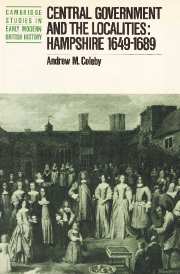Book contents
- Frontmatter
- Contents
- List of maps
- Acknowledgements
- List of abbreviations
- INTRODUCTION AND PROLOGUE
- PART I THE INTERREGNUM
- PART II THE RESTORATION
- THE RESTORED MONARCHY AND THE ROLE OF GOVERNMENT
- 4 LOCAL OFFICE-HOLDING 1660–78
- 5 THE ENFORCEMENT OF POLICY 1660–78
- 6 COURT AND COUNTY 1660–78
- PART III FROM THE POPISH PLOT TO THE REVOLUTION OF 1688
- EPILOGUE AND CONCLUSION
- Bibliography
- Index
5 - THE ENFORCEMENT OF POLICY 1660–78
Published online by Cambridge University Press: 14 October 2009
- Frontmatter
- Contents
- List of maps
- Acknowledgements
- List of abbreviations
- INTRODUCTION AND PROLOGUE
- PART I THE INTERREGNUM
- PART II THE RESTORATION
- THE RESTORED MONARCHY AND THE ROLE OF GOVERNMENT
- 4 LOCAL OFFICE-HOLDING 1660–78
- 5 THE ENFORCEMENT OF POLICY 1660–78
- 6 COURT AND COUNTY 1660–78
- PART III FROM THE POPISH PLOT TO THE REVOLUTION OF 1688
- EPILOGUE AND CONCLUSION
- Bibliography
- Index
Summary
DEFENCE AND INTERNAL SECURITY
The Restoration saw changes in the structure of local defence and security arrangements. But these should not distract attention from the fact that the Restoration government was just as involved in the provinces for these purposes as its Interregnum predecessors had been, at least for the first seven years of Charles II's reign. The government was equally capable of interfering in the localities to ensure its own safety and was in many ways more successful in the policies which it pursued than the regimes of the 1650s.
In the years which immediately followed the Restoration, the hand-picked lieutenancy in Hampshire was plied with detailed instructions from the Privy Council. These concerned the mustering of militia, the observation, disarming and detention of those disaffected to the government, and the suppression of false news. Though the earl of Southampton was confined to London by government business or illness, his deputy-lieutenants were not simply left to their own devices, but were expected to return detailed accounts of their proceedings to Southampton and the Privy Council, a requirement which they gladly fulfilled. This stream of orders, which slowed down somewhat between 1663 and the outbreak of the second Dutch War, thereafter resumed until peace was concluded, with a new emphasis on the defence of the coast.
- Type
- Chapter
- Information
- Central Government and the LocalitiesHampshire 1649-1689, pp. 104 - 141Publisher: Cambridge University PressPrint publication year: 1987

